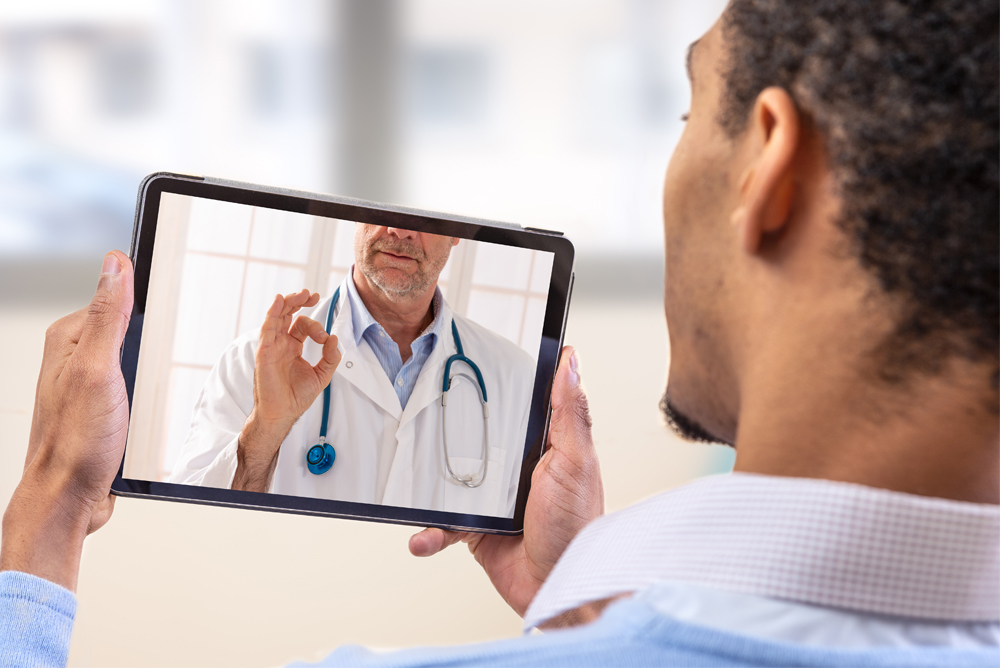- Speak to a licensed sales agent!
- (800) 521-7873
How Telemedicine is Shaping the Post-COVID Health Industry

COVID-19 has completely changed many aspects of American life, possibly forever, and the healthcare industry is no exception. As COVID-19 becomes a daily reality, both patients and healthcare providers are looking for ways to reduce potential contact with infectious diseases while still providing necessary treatment.
As the healthcare industry continues to change, many providers have started using what is known as telehealth or telemedicine to provide treatment to their patients in a safer, more accessible, and often cost- and time-effective way. Though telehealth has been in use for years now, because of this newly increased demand for virtual doctor’s visits and care, many believe that this system will continue to become an integral part of the way health care is offered and implemented in the future.
What Are Telehealth and Telemedicine?
Telehealth, or telemedicine, are terms that describe the provision and receiving of health care and clinical services through various functions of communication technology. For example, this may mean that you can attend a doctor’s appointment with your primary care physician over the phone or through a video call, upload your own medical information to be directly accessed by your doctor, request prescriptions and refills, see your medical records and test results on an online patient portal, and many other useful functions without leaving the comfort of your home.
For some organizations, there is a distinction between telemedicine and telehealth. Telemedicine refers specifically to clinical services (including monitoring and diagnosing patients), while telehealth is a more general term that includes telemedicine as well as other, non-clinical services such as preventative care.
However, the term telemedicine is still frequently used interchangeably with telehealth, as they both denote virtual health care. There are also many different branches within the scope of telehealth such as telepharmacy, telecardiology, and many others. Different healthcare providers also have their own specific telehealth systems, which can vary in the range and methods of their services.
The virtual and technological aspect of this service allows for instant communication not only between medical professionals but also between those professionals and their patients. It also promotes access to health care in many forms, as well as remote monitoring and recording of medical data to further assist patients in these distance appointments.
What Telemedicine Can Offer
Telehealth and telemedicine can offer a wide array of benefits that are difficult to accomplish through traditional in-person health care. First and foremost, telehealth makes health care more accessible to underserved or marginalized populations. This is especially helpful for those in lower socioeconomic levels as well as those who live in rural communities or live far away from adequate healthcare facilities.
These individuals are often less likely to have access to reliable transportation to a healthcare facility and may instead rely on others to take them, or be forced to consider more expensive options such as ride-sharing. Additionally, for those who work several jobs or long hours, taking time off from work may be a difficult or even impossible task in their situation.
For patients in these circumstances, telehealth provides a much more accessible option by conducting appointments via phone or video which eliminates the need for these patients to come into a clinic or doctor’s office for non-emergent reasons such as a checkup or an update on new information. This also provides much-needed flexibility in scheduling appointments as well as avoiding potentially long wait times.
In addition, accessibility also extends to more vulnerable members of the population, especially in our current situation with COVID-19. There are many elderly, disabled, and immuno-compromised individuals that find it difficult to leave their homes due to the risk of contracting COVID-19.
Virtual appointments through telehealth ensure the safety of these at-risk individuals by limiting the risk of contracting any contagious illness from a doctor’s office, which is invaluable for medically vulnerable groups. This virtual aspect relieves that stress and allows the patient to discuss things with their doctor from the comfort of their home instead of having to potentially put themselves through a stressful situation for something that could be done over a 15-minute phone call.
Of course, telehealth and telemedicine cannot completely replace all medical services, but there are some services and situations that are ideal for this kind of communication with your doctor. These include requesting prescription refills or changes as well as reviewing test results and discussing the next step of treatment.
Moreover, it’s easy to assume that the personal connection between a patient and a doctor would be lost in the distance caused by using technology, but this is not always the case. In fact, virtual appointments and consultations through video calls can allow doctors to see a unique perspective into the life of their patients at home that might not normally be apparent in the doctor’s office.
Finally, remote patient monitoring can provide numerous benefits by using technology such as smartphones or other wearable medical devices to collect various health data from patients in real-time. This can be helpful for monitoring elderly patients in the case of a fall or other medical emergency. Diabetic patients can also heavily benefit from this function as they can easily record their insulin levels which could also be seen and monitored by a doctor.
Drawbacks to Consider
Telemedicine, however, does not come without its drawbacks, many of which stem from actually using and implementing the technology. Some patient populations, for example, may lack the resources to be able to effectively use and get the most out of telehealth.
These problems can come in the form of not having access to a smartphone or laptop, or maybe even not having adequate access to wifi. Internet connectivity is a pervasive issue for many who live in impoverished and rural communities, who are often the ones who can benefit the most from this service.
Additionally, older or disabled patients may find it difficult to use the online system and patient portal. This issue is made more complicated by the fact that not all telehealth systems are the same. Some may offer more options in regards to video appointments and how to access your information while others tend to rely more on phone calls.
Because telemedicine can’t completely replace all doctor’s visits, there can be issues with relying on virtual appointments. For example, when consulting with a doctor over the phone or on a video call about a condition or medication, there is the risk that something could be missed, or the doctor might be unable to get as good of an understanding of your condition than if you were in person.
This can also cause the doctor to take a longer time to diagnose a patient and get the treatment they need than if they were meeting in an office. Whether you are using telehealth services or not, if your doctor recommends it, or if you feel there is a deeper problem, it is better to make an in-person visit. Additionally, if proper communication doesn’t take place between doctors, there is a chance that you could be given incorrect information and that your care could be fragmented, leaving gaps of information that may be difficult to find or address.
Affording Telehealth
Telehealth can be very cost-effective for both the patient and the medical provider. Telehealth can help hospitals and clinics save money on facility and staff costs as well as expenses associated with appointment cancellations and no shows. It can also cut down on unnecessary appointments and emergency room visits.
For a patient, the savings are also clear. While an in-person visit to a clinic can be expensive, the average telehealth appointment can be as little as half of the normal cost. This makes telehealth appointments much more affordable than similar in-person visits, especially when transportation also contributes to the cost.
However, the savings can depend on a variety of factors such as follow-up visits, which are more likely to happen in the case of virtual appointments. As for health insurance and Medicaid, the situation can vary, so you will need to contact your provider to find out more if your coverage has changed or has been affected in any way by telehealth.
The Future of Telemedicine
Due to the COVID-19 pandemic bringing some hospitals to maximum capacity, there is a growing concern that we might encounter a similar situation in the future, with some patients unable to receive the care they need as a result. As the world continues to adjust to this disease, it seems that telehealth will be able to meet the needs of patients and the healthcare industry, especially as the demand for this system continues to increase.
In understanding all the benefits that telehealth has been able to provide, many healthcare providers are considering implementing it into their services. In fact, some have already been using and integrating this service for months now. For many patients and providers, using telemedicine has already brought about benefits and improvements to their lives, affirming that the use of telemedicine and remote patient monitoring is likely here to stay, and see growth in the future.
Your Health and Life Insurance
Telehealth and telemedicine services provide health care in ways that were not possible before. Through the strategic use of technology, these services can help bring accessibility and comfort to you as a patient.
Just as telehealth aims to protect your health when you may need an alternate option, life insurance can protect your loved ones when the unthinkable happens. There are many unexpected and uncontrollable situations in life and don’t want to have to worry about your family’s future.
A life insurance policy will help safeguard the financial future of your loved ones and dependents if something were to happen to you. However, with many policies requiring a medical exam, many providers are experiencing challenges with underwriting new policies and applicants aren’t able to attend in-person exams. While these providers are still open for business and issuing new policies, the process has been made more difficult due to the COVID-19 outbreak.
Telehealth changes the average person’s access to both health care and life insurance simultaneously. Obtaining medical records, keeping appointment dates, and maintaining follow-up care are all possible remotely with the advantages that telehealth brings.
However, not all policies require medical exams. For those that value convenience, privacy, and safety during this period, no medical exam policies may be a good option. Rather than go through an in-person exam or even conduct one through telehealth, you will only have to answer a few health and lifestyle questions over the phone to obtain coverage. However, it’s important to speak with a life insurance agent to determine if a no medical exam policy is right for you.
How LifeQuote Can Help
At LifeQuote, we have a variety of plans that can suit your needs. We offer flexible term policies in addition to whole life plans as well as no medical exam policies for speed, safety, and convenience. With so many industries making changes and adapting to our world with COVID-19, choose life insurance to make the change you need and get a free quote from us today.




